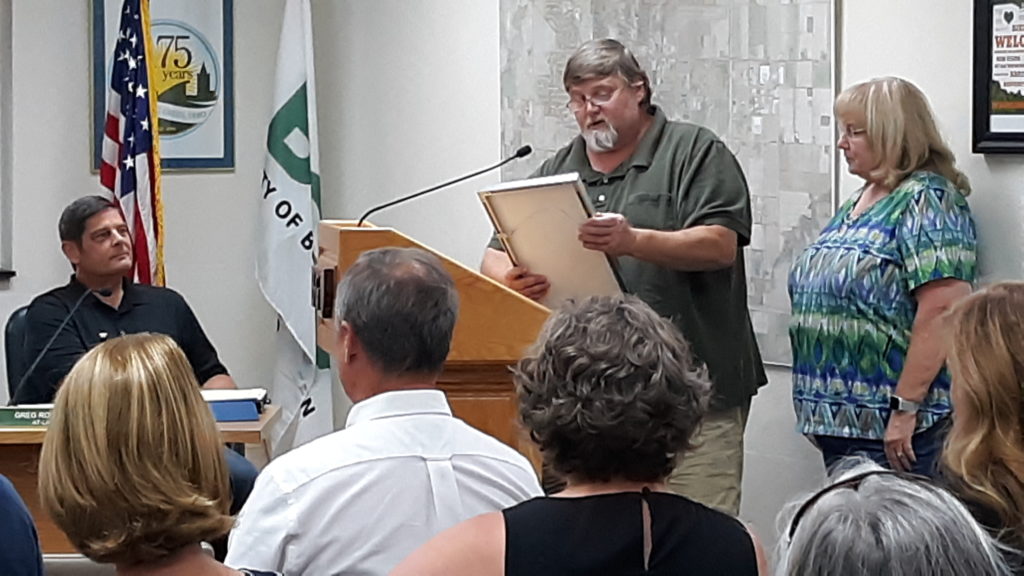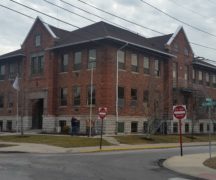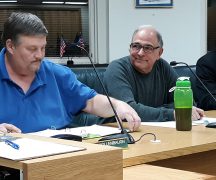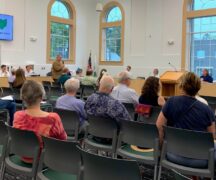By JAN LARSON McLAUGHLIN
BG Independent News
Bowling Green City Council pushed the accelerator Monday evening on legislation urging an end to stop and go traffic between here and Columbus.
In anticipation of Mayor Mike Aspacher meeting with Gov. Mike DeWine next week, Bowling Green City Council suspended the rules Monday evening and gave a third reading of legislation asking the state to continue studying how to relieve congestion on U.S. 23.
Council voted unanimously to adopt the resolution.
“We want to put a little more weight behind that” as the mayor meets with DeWine, said City Council member Rachel Phipps.
As chairman of the Toledo Metropolitan Area Council of Governments, Aspacher is planning to talk with the governor about Route 23 during a meeting set up by the Toledo Chamber of Commerce.
“I definitely support the study of an improved corridor between Bowling Green and Columbus,” Aspacher said after Monday’s council meeting.
“It really is a barrier to commerce,” he said, noting the 38 traffic lights in the 37 miles on U.S. 23 between Waldo and northern Columbus. No other region of Ohio has to deal with stop and go traffic to get to the state capital, Aspacher said.
Until recently, the congested route was being studied for solutions. But the Ohio Department of Transportation halted the study.
The resolution passed by Bowling Green City Council, and by several other governmental entities in this area, urges DeWine and ODOT to reconsider the decision to end the “Route 23 Connect” study.
The study was looking at an improved highway connection between Northwest Ohio and Columbus. The resolution asks DeWine and ODOT to continue investigating improvements, upgrades, a bypass and other possibilities to address increased traffic along Route 23 through Delaware County.
The Bowling Green resolution cites benefits of an improved Route 23 corridor as reduced congestion, improved travel times, decreased crash rates, and a strengthened connection between Northwest Ohio and Columbus – which provides additional access to domestic and international markets for both regions.
TMACOG has long advocated for an improved highway connection to the state capital, and last year partnered with the Ohio Department of Transportation and the Mid-Ohio Regional Planning Commission to study options to improve travel between Waldo and Interstate 270.
But ODOT officials decided that none of the six proposed options could be “reasonably implemented,” and that they would cost more than they would provide in benefit.
However, many leaders across this region disagree. A clogged Route 23 slows down travel and the local economy.
Northwest Ohio is the only metropolitan area in the state without a free-flowing connection to the capital. Drivers from Cleveland, Youngstown, Akron, Canton, Dayton, and Cincinnati encounter zero stop lights on highways enroute to Columbus, according to TMACOG.
The need for a better connection has been in TMACOG’s Transportation Legislative Agenda since 2008 and has been noted in long-range plans since at least 1996. According to TMACOG:
- Route 23 already has 30 percent more traffic than it was designed for. This has caused increased congestion, unpredictable travel times, and higher crash rates.
- Bottlenecks are frustrating for travelers and impede commerce and freight, making it harder to do business and attract new companies.
- As the area continues to develop, this problem will only get worse.
- The region expects to add more than 1 million households and 1 million jobs over the next 20 years, according to the Mid-Ohio Regional Planning Commission.
- The federal government is doing its part putting America on track to address the nation’s infrastructure needs, with a myriad of potential funding opportunities. Fixing Route 23 should be among the priority projects for Ohio.
Also at Monday’s meeting, two long-time employees – City Attorney Mike Marsh and former City Clerk Kay Scherreik – were recognized for their service.

Marsh was presented a commendation from the Ohio House of Representatives by Rep. Haraz Ghanbari, R-Perrysburg, and was met by friends and family at the end of the meeting.
In keeping with his tradition of brevity at City Council meetings, Marsh had no report other than to praise his replacement, Hunter Brown.
“In two weeks, I can report Hunter Brown will be sitting in that chair,” Marsh said. “He’s going to do a good job for you.”
Scherreik was presented a resolution acknowledging the hundreds of meetings she kept record of and the more than 5,000 pieces of legislation she helped prepare over three-plus decades.

In other business, Joe DeMare, co-chair of the Wood County Green Party, said the party does not support the financial incentives proposed to encourage Bowling Green residents to put solar power on their roofs.
“We don’t really need or want to be subsidized by taxpayers,” he said.
While the incentives have the potential of doubling the rooftop solar systems in the city, they would not address the “structural impediments” put in place by the Board of Public Utilities, DeMare said.
Also at the meeting, council member Bill Herald shared constituent concerns about the long wait time at the downtown crosswalk between Ben’s and Juniper.
Bowling Green Public Services Director Joe Fawcett said the crosswalk lights are sequenced with the traffic lights to the north and south on Main Street. He has consulted the city engineer in the past to determine if the timing should be adjusted, but has been told the sequencing works for traffic flow. Fawcett said he will check again with the engineer.
Also at the meeting:
- Kat Patterson, from Visit BG Ohio, announced that the Vintners in Northwest Ohio will be hosting a wine festival in Bowling Green, on Oct. 8, from 1 to 7 p.m., at the Wood County Fairgrounds. Local businesses will be partnering on the event.
- Kristen Kreienkamp, event lead at the Bowling Green Chamber of Commerce, said the 67th holiday parade is planned for Nov. 19, with the theme of “Toys, Trains and Candy Canes.” The chamber is looking for parade entries, volunteers and sponsors.
- Sean Brennan voiced his support of the city’s zoning code update, with one exception being the 5-foot setback in the pedestrian residential zoned areas.





